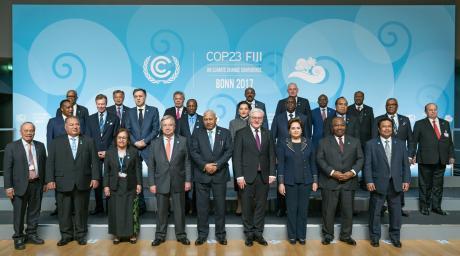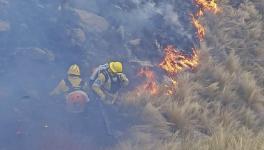Climate Talks End with Adoption of ‘Fiji Momentum for Implementation’

The 23rd session of the Conference of the Parties (COP23) to the UN Framework on Climate Change (UNFCCC) closed early morning of Saturday18 Nov, a day later than its scheduled ending, with the adoption of what was called the “Fiji Momentum for Implementation”, (also known as decision 1/CP.23).
The COP 23 closing plenary was supposed to convene in the morning of Friday,17 Nov, but it only began past 4.30 a.m on Saturday, in Bonn, Germany.
The stance of the United States (US) in particular, especially over some finance related issues relating to the implementation of the Paris Agreement (PA), was the main source of contention between developing and developed countries. It took long huddles among Parties on the Conference floor to iron out a solution, given the U.S position.
Even though the US has notified Parties that it does not intend to remain a Party to the PA, it remains a Party until it legally withdraws from the Agreement in Nov. 2020. Despite its intention to leave, the US role in the Bonn climate talks were viewed by senior negotiators from developing countries and some observers as being “very problematic.”
What was seen as being even more outrageous was the approach taken by the UNFCCC Secretariat, which what some sources described as an attempt to “cover up” the US opposition to an initial draft of the COP 23 decision by claiming that there was a “typo error” in the document, which drew protests from several developing country negotiators, who wanted an explanation as to why the later version of the draft decision had some issues removed and was different from an earlier iteration of the same.
All this happened on the floor of the Conference hall, before the COP closing plenary convened. Parties were seen engaged in a very long huddle to seek a solution on the matter, which was resolved by a footnote in the document (See details below).
The US it seems was opposed to the reflection of some issues as part of the Paris Work Programme (PWP) which included ‘modalities for biennially communicating information on the provision of public financial resources to developing countries’ under the PA and the setting of a new collective quantified goal on finance from a floor of USD 100 billion per year, which is to be agreed to 2025.
Other divergences among Parties that led to the delay in the convening of the closing plenary of the Ad Hoc Working Group on the Paris Agreement (APA) and the COP related to finance issues in relation to the Adaptation Fund, as well as a process to identify indicative quantitative and qualitative information that developed countries are biennially required to communicate under Article 9(5) of the PA.
The COP 23 Presidency carried out several rounds of informal consultations with Parties to resolve these differences, which were eventually resolved.
Fiji Momentum for Implementation
The ‘Fiji momentum for implementation’, as adopted, is divided into three parts: Part 1 deals with the ‘Completion of the Work Programme under the PA’; part 2 deals with the ‘Talanoa Dialogue’ (which is the Facilitative Dialogue to be conducted in 2018); and part 3 deals with ‘pre-2020 implementation and ambition’.
Completion of the Work Programme under the PA
Sources revealed that there was considerable divergence among Parties on how to reflect the completion of the work programme under the PA.
In the decision adopted, the COP requested the Secretariat to develop an online platform to provide an overview of the work programme of the PA being carried out in the various subsidiary and constituted bodies, including the APA.
The overview is to be based on a list provided in Annex 1 of the decision, and it was one of the items in the list that became the bone of contention among Parties.
Two different versions of the list were made available to Parties in two separate iterations of the draft decision titled decision 1/CP.23.
In the first version, released on 17 Nov at 10.30 p.m, the list provided details of the work being carried out under the COP and the subsidiary and constituted bodies on the work programme under the PA for the first session of the Conference of the Parties serving as the meeting of the Parties to the PA (CMA).
Under one of the items on “other matters relating to the implementation of the PA (APA)”, the following were listed:
“(a). Modalities for biennially communicating information on the provision of public financial resources to developing countries in accordance with Article 9(5); (b). Initial guidance by the CMA to the operating entities of the Financial Mechanism (the Green Climate Fund and the Global Environment Facility) under Article 9(8)…(c). Initial guidance by the CMA to the Least Developed Countries Fund and the Special Climate Change Fund …; (d). Guidance by the CMA on adjustment of existing nationally determined contributions under Article 4 (11), (e). Setting a new collective quantified goal on finance….”
(In Paris in 2015, COP 21 assigned various tasks related to the PA implementation to several bodies, which included the APA, and the subsidiary bodies of the Convention among others. There were several matters that were not assigned to any of the bodies, which Parties referred to as “homeless”. The list above refers to the “homeless” matters.)
In the second version of the draft decision released on 18 Nov at 12.30 a.m., the item changed to: “Possible additional matters relating to the implementation of the Paris Agreement (APA)”.
The second iteration of the draft decision was to be presented to Parties for adoption.
According to sources, developing countries were not happy as to why the change happened and why the listing of the additional matters disappeared from the second iteration of the draft decision without any explanation.
Developing countries were concerned about these finance related issues being dropped from the second iteration, which are viewed by them as being key for them to be able to implement the PA.
According to sources. the US was of the view that there was no need to include these matters in the PWP and that these matters did not need to be reflected in the online platform.
Developing countries led by Egypt for the African Group, China andSaudi Arabia for the Arab Group were seen discussing the issue in a huddle expressing their concerns as the matters that were dropped from the list were integral to the implementation of the PA and there could be no justification to exclude them from the list. They were joined by other developing countries too as well as someone from the UNFCCC Secretariat who explained that there had been a “typo error.” It seems the developing country delegates countered the explanation that it could not be a “typo error” as the changes made were “substantive”.
The US also joined the huddle and according to sources, and said that it disagreed with developing countries and maintained that there was no clarity that the additional matters were part of the PWP and which needed to be addressed by the first session of the CMA. Sources also said that the US was resolute in its stand and refused to accept the inclusion of these matters.
After lengthy deliberations in the huddle, a compromise was reached in the form of a footnote, which Parties said should reflect that there was no consensus on the matters to be addressed under the PWP.
The footnote, as adopted, reflects as follows: “Different views are expressed by Parties on whether possible additional matters should be added to the work programme under the PA for the first session of the CMA, including the issues discussed under agenda item 8 of the APA.”
The first session of the CMA, to be held next year, is bound to see a heated debate on whether the additional matters should be added to the PWP.
The decision adopted in relation to the work programme also confirmed the determination of Parties to “oversee and accelerate the completion of the work programme under the PA” by COP 24 in Dec. 2018; and also decided that the COP23 President would consult with the bureau of the COP and the Co-chairs of the APA and assess “the need for the additional negotiating session” on the basis of the outcomes of the May session in 2018.
Talanoa Dialogue
The decision adopted also welcomed “with appreciation” “the design of the 2018 facilitative dialogue, to be known as the Talanoa dialogue… as contained in the informal note by the Presidencies of the twenty-second and twenty-third sessions of the COP.”
Since the informal note was not a negotiated document, how it was to be reflected in the decision became a bone of contention.
In Paris, Parties had agreed to “convene a facilitative dialogue among Parties in 2018 to take stock of the collective efforts of Parties in relation to progress towards the long-term goal referred to in Article 4 (1) of the Agreement and to inform the preparation of nationally determine contributions (NDCs) pursuant to Article 4(8) of the Agreement.”
Before COP23 began, the Presidencies of COP 22 (Morocco) and COP 23 had prepared an informal note to inform Parties on their consultations on the organization of the 2018 facilitative dialogue, which they referred to as the “Talanoa Dialogue”.
The informal note provides a description of the “features” of the dialogue, which among other things, states that “the dialogue will be conducted in the spirit of the Pacific tradition of Talanoa” which is “a traditional approach used in Fiji and the Pacific to engage in an inclusive, participatory and transparent dialogue” with the purpose of sharing “stories, build empathy and trust.”
According to the note, “the dialogue will be structured around three general topics: where are we; where do we want to go and how do we get there.” The dialogue is supposed to consist of a preparatory and a political phase, with the COP 23 President and the COP 24 President (Poland) providing a summary of key messages from roundtables to be held in 2018.
The note also states that “Parties, stakeholders and expert institutions are encouraged to prepare analytical and policy relevant inputs to inform the dialogue and submit these and other proposed inputs…” and “summaries from all discussions will be prepared under the authority of the Presidencies of COP 23 and COP 24”.
The note further states, “It will be important to send clear forward looking signals to ensure that the outcome of the dialogue is greater confidence, courage and enhanced ambition”.
During COP23, the Fijian Presidency further consulted with Parties on the dialogue.
In a non-paper issued by the Presidency on 16 Nov, it was mentioned that Parties “take note of the announcements by the President of the COP22 and the President of the COP23 on the approach regarding the design of the 2018 Talanoa dialogue”.
However, in a non-paper issued on the same day at 10 p.m, the language changed to: “Endorses the design of the 2018 Talanoa dialogue ….”
Sources said that besides disagreements on how to reflect the approach to the design in the decision, there were differences of view on the design elements of the dialogue as well. These were around the involvement of expert institutions, the involvement of the Presidencies, and the outcome of the dialogue itself.
During the informal consultations on the matter, it emerged that the Alliance of Small Island States (AOSIS) and the Least Developed Countries (LDCs) wanted to use the term (Parties) “decide” to be reflected.
However, the US and New Zealand were opposed to this as the design contained in the informal note “was not negotiated by Parties” and that it was only a proposal of the Presidencies.
Other Parties, both from developed and developing country groups, supported the approach laid down by the Presidencies. The European Union said it could accept the design “in the spirit of compromise”.
Sources also said that the Like-Minded Developing Countries (LMDC) and the Arab Group, sought a number of clarifications on the design of the dialogue. The LMDC wanted to know in what capacity ‘expert institutions’ would be involved in the process and what was meant by ‘expert institutions’. The LMDC was of the view that it should be a Party-driven process and that the reports of the dialogue should be Party-driven and not left to the Presidencies.
China supposedly also sought clarification on a host of different issues, including on the outcomes of the dialogue. India also cautioned against engaging expert organizations without defining who they would be and that the outcome of the dialogue should stop at providing information to Parties.
According to sources, Saudi Arabia said that the facilitative dialogue should be kept simple and should not be over-designed, adding that the document should not give an impression that it was negotiated, since not all the views had necessarily been captured in the design.
After further consultations, it was decided that the words, “welcomes, with appreciation…” would be used in the final decision adopted. The decision also states that the dialogue will start in January 2018.
Pre-2020 implementation and ambition
When COP 23 began, developing countries, led by the LMDC had insisted that there an agenda item on pre-2020 action be included into the COP’s agenda. This was resisted by developed countries and following informal consultations conducted by the COP Presidency, consensus was found in having a decision on ‘pre-2020 implementation and ambition’ in the final decision adopted on Saturday.
The decision among other things, includes the following:
- It requests the President of the COP and the UNFCCC Executive Secretary to send joint letters to Parties to the Kyoto Protocol (KP) that are yet to ratify the Doha Amendment to the KP urging them to deposit their instruments of acceptance with the Depositary as soon as possible;
- it also requests the Secretariat to consult the UN Secretary-General on ways to promote the ratification of the Doha Amendment to the KP;
- it invites Parties to submit via the submission portal by 1 May 2018 additional information on progress in implementing the decision taken in Paris on ‘enhanced action prior to 2020’;
- it requests the Secretariat to prepare a synthesis report of the submissions referred as input to the stocktake to be convened (reflected below);
- it welcomes the report of the President of the COP that noted that the 2018 Talanoa dialogue will consider, as an element of the dialogue, the efforts of Parties in relation to action and support, as appropriate, in the pre- 2020 period;
- it decides to convene a stocktake on pre-2020 implementation and ambition at COP 24, which will apply the format of the 2016 facilitative dialogue and consider, inter alia:
(a) The inputs of the COP, the Conference of the Parties serving as the meeting of the Parties to the Kyoto Protocol (CMP), the Subsidiary Body for Implementation, the Subsidiary Body for Scientific and Technological Advice, the constituted bodies under the Convention and the Kyoto Protocol, and the operating entities of the Financial Mechanism;
(b) The mitigation efforts of Parties in the pre-2020 period;
(c) The provision of support in the pre-2020 period;
(d) The work of the Marrakech Partnership for Global Climate Action, including the summaries for policymakers of the technical examination processes and the yearbooks on climate action prepared by the high-level champions;
- it also decided to convene a stocktake on pre-2020 implementation and ambition at CO 25, which will apply a similar format as the 2018 stocktake and which will also consider the outcomes of the high-level ministerial dialogue on climate finance to be held at COP 24; and
- it also requests the Secretariat to prepare reports on the stocktakes to be held in 2018 and 2019.
Disclaimer: The views expressed here are the author's personal views, and do not necessarily represent the views of Newsclick.
Originally published at TW Network
Get the latest reports & analysis with people's perspective on Protests, movements & deep analytical videos, discussions of the current affairs in your Telegram app. Subscribe to NewsClick's Telegram channel & get Real-Time updates on stories, as they get published on our website.























